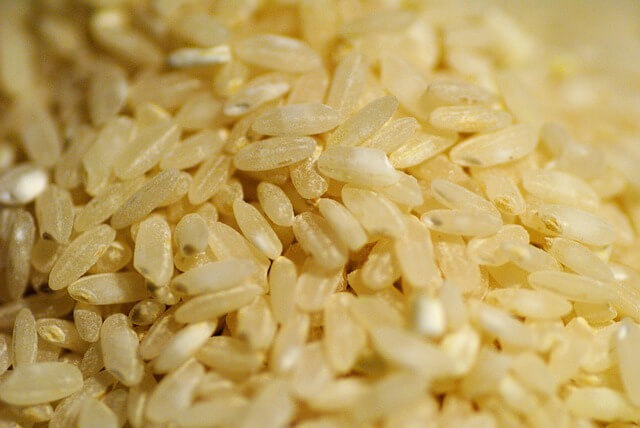When you think of sushi, you probably think of the sticky white rice used to make it. While sticky rice is excellent to use when making sushi due to its sticky texture, it’s not the healthiest rice option. Brown rice has many health benefits, and you can use it to create your favorite sushi dishes.
To make sushi using brown rice, you need to:
- Collect your ingredients.
- Prep your brown rice.
- Mix your brown rice with a vinegar mixture.
- Spread a thin layer of brown rice on a sheet of nori.
- Position the nori sheet however you prefer.
- Add additional ingredients.
- Use a bamboo mat to roll the sushi.
- Cut the roll into pieces.
- Add wasabi, soy sauce, and enjoy.
Along with discussing how to make sushi using brown rice, I’ll also go over the health benefits of using brown rice over sticky rice, different ingredients you can add to your sushi, and tips on how to season your brown rice.
1. Collect Your Ingredients
Before you begin, you’re going to want to collect all the ingredients you want to use in your sushi roll. Along with the necessary brown rice, pick out some other popular (or not popular) ingredients to add to your sushi roll to make it delicious.
Some delicious, healthier options to add to your sushi roll might include:
- Avocado: Full of vitamins and a great source of beta-carotene and omega-3 fatty acids.
- Cucumber: Good source of vitamins K, B, and C, as well as potassium and magnesium.
- Carrots: Contains beta-carotene, fiber, many vitamins, and antioxidants.
- Shrimp: A great source of protein and omega-3 fatty acids.
- Sprouts: Good source of vitamin K, as well as magnesium, phosphorus, and folate.
- Salmon: Rich in omega-3 fatty acids and potassium.
Along with the ingredients you want to use in your sushi roll, you’ll want to have some nori sheets, which are the dried seaweed that holds sushi rolls together. You also might want a rice cooker to make the cooking process easier (which I’ll get into later) and a bamboo mat to easily roll your sushi.
2. Prep Your Brown Rice
Since brown rice isn’t naturally sticky like sticky rice, it needs to be prepped a certain way to be used in a sushi roll. Substituting regular brown rice for sticky rice when making sushi will leave the rice all over the place.
First, you’ll want to parboil your brown rice in advance. While this isn’t necessary, parboiling rice ahead of time will cut down on how long it takes to make your sushi meal. Typically, brown rice takes around 40 minutes to cook. Parboiled, however, will half that cooking time when you decide to make your sushi rolls.
After the optional prep of parboiling, to continue cooking the brown rice, use a stovetop or a rice cooker, such as the Hamilton Beach Digital Programmable Rice Cooker from Amazon.com. This rice cooker is an excellent investment if you make sushi (or just rice) often. The product is an inexpensive option, and it makes cooking rice less stressful. Also, as it’s all electronic, you don’t have to constantly check on it while it cooks.
While you can also cook your brown rice on the stove, brown rice takes longer to cook than many other kinds of rice, so it will take longer, and you’ll have to stir it frequently. Therefore, I would recommend just getting a rice cooker.
3. Mix Your Brown Rice with a Vinegar Mixture
After thoroughly cooking your rice, you’re going to need to add a vinegar mixture. This step is essential because this will make your brown rice more sticky, like sticky rice, which makes creating the sushi roll so much easier.
You can create your own vinegar mixture using rice vinegar, such as this Marukan Rice Vinegar from Amazon.com. This rice vinegar is also already sushi-seasoned, which will give the brown rice an extra delicious flavor.
While you can also create your own rice vinegar, the process is a bit time-consuming, so I recommend just buying rice vinegar instead. You’ll want to add a little sugar and salt with this rice vinegar and put the mixture on the stove until the sugar has completely dissolved.
After the rice is finished and cooled off, slowly add the vinegar mixture while stirring the rice. You want to make sure the rice isn’t too warm, as it can make it more difficult with sushi. Once the vinegar mixture is thoroughly stirred in, the brown rice should have a bit of a sticky consistency.
4. Spread a Thin Layer of Brown Rice on a Sheet of Nori
After adding the vinegar mixture to the rice, you’re ready to start constructing the sushi roll. Layout a sheet of nori, and spread a thin, even layer of the brown rice all over. You don’t want it to be too thick so you can fit the other ingredients in the roll.
Figuring out the thickness of the rice might take a few tries, so I recommend trying to roll one sushi roll before constructing others, so you have a better idea of how much rice to use.
This will also give you an idea of how much rice you prefer in your sushi rolls since brown rice has a different flavor, and therefore won’t taste the same as the sticky rice does.
5. Position the Nori Sheet However You Prefer
After you have spread a thin layer of rice on the nori sheet, you’ll want to position the sheet however you prefer before adding ingredients. Some sushi rolls have the nori on the outside with the sushi on the inside. However, the rice is also commonly seen on the outside of the roll.
If you want the rice on the outside, carefully flip the nori sheet over. I recommend putting saran wrap on top of it before flipping it over, so it stays in place.
I recommend buying the ONE ORGANIC Sushi Nori Premium on Amazon.com if you’re looking for nori sheets. These seaweed sheets are entirely organic, making them a healthy option to go with brown rice. They’re low-calorie, packed with several vitamins, minerals, and amino acids. Each sheet is also a good size for sushi rolls, so you won’t have to cut the sheets yourself.
6. Add Additional Ingredients
Once the brown rice is in the right place, add whatever ingredients you want to the roll. Like with the brown rice, make sure not to pack too much of each ingredient because it will make it harder to roll and even harder to eat if each roll is too thick.
If you’re choosing to use brown rice over white rice because you’re trying to be more health-conscious, then there are many healthy ingredients you can add to your roll, like carrots and salmon, as I already mentioned before.
7. Use a Bamboo Mat To Roll the Sushi
After adding all of your ingredients, you’re ready to roll your sushi! Using a bamboo mat is the easiest way to roll your sushi without causing a mess.
If you’re looking for a great one, I recommend this Sushi Making Kit from Amazon.com. Not only does it come with an excellent bamboo mat to roll your sushi, but it comes with five sets of chopsticks (great for eating sushi with), a rice paddle, and a spreader, making your sushi-making experience so much easier.
When you use a bamboo mat, it’s a good idea to wrap it in saran wrap. Doing this makes the clean-up process more manageable, and the sushi roll won’t stick to the bamboo mat.
If you’re more of a visual learner and want to watch a professional roll sushi using a bamboo mat, here’s a quick three-minute video from How Daily:
8. Cut the Roll Into Pieces
After you’ve rolled the sushi roll and you’ve let it sit for a few minutes, you’re ready to cut your slices! This step is easy to mess up because slicing into the roll might make the filling fall out and cause a mess.
However, if you wrap your sushi roll in saran wrap before cutting it, it will be a lot easier. You can even use the same wrapping you used on the bamboo mat to save time.
There are even specially crafted knives specifically for cutting sushi and sashimi. This Stainless Steel Sushi Sashimi Knife from Amazon.com has excellent reviews. It’s decently priced compared to many other sushi knives and is exceptionally sharp, making it almost effortless to cut through sushi rolls.
9. Add Wasabi, Soy Sauce, and Enjoy
Once your sushi roll is all complete, add the sushi roll essentials, like wasabi, soy sauce, and maybe even some ginger. While your sushi roll made with brown rice rather than the usual sticky rice might taste a little different, it’s way better for you, and you’ll still get to eat your favorite delicious sushi dishes. Not to mention all the hard work you put into making the sushi!
Is Sushi Healthy With Brown Rice?
Sushi is healthy with brown rice. That’s because brown rice offers many health benefits that white rice doesn’t have, such as a low glycemic index and it’s a whole grain rice option. Therefore, brown rice reduces your risk of diabetes and offers many essential nutrients.
In general, sushi is considered a healthier food, especially for people who are trying to lose weight. Sushi is typically packed with protein and nutrients because of the fish and veggies inside the roll. Rice, however, is usually the harmful component of many sushi rolls.
While both white rice and brown rice are high in carbohydrates, substituting white rice with brown rice for sushi will still be way more beneficial. Along with reducing your risk of diabetes, eating brown rice will reduce your risk of stroke and heart disease.
What Are the Benefits of Using Brown Rice?
Along with being whole grain, brown rice can improve heart health and lower the risk of diabetes. The low glycemic index (GI) of brown rice won’t spike your blood sugar. Therefore, eating several servings of brown rice is considered healthier than eating white rice.
Brown rice is undeniably one of the healthiest rice options out there. Brown rice is whole grain rice, which is more nutritious because the less processed the grain is, the more nutrients there are. Because brown rice contains the bran and the germ, which are essential to providing nutrients, it has the most health benefits.
When white rice is processed, both the bran and the germ are removed, stripping away essential nutrients in the rice.
Often when you eat sushi, you’re consuming more rice than you realize. Therefore, when you’re eating sticky rice on your sushi rolls, it might seem like you’re not eating that much rice when in reality, you are. Using brown rice rather than white rice ensures you don’t unintentionally spike your blood sugar and supplies extra nutrients.
Many plant species thrive in humid environments, so they may experience transpiration if the humidity is low, especially when you’re not regularly watering them. While there are many ways to increase moisture in the air, you may want to invest in an air moisturization device if you live in arid climates or experience dry seasons.
What To Add To Make Brown Sushi Rolls Taste Better
Maybe you opt for brown rice because it is healthier than white rice. Or maybe you ran out of white rice, so you decide to use brown rice instead. But you don’t like the taste of brown rice all that much.
Soy sauce, mirin, salt, and garlic salt are all ingredients that can make brown sushi rolls taste less overpowering. I recommend adding a bouillon cube when cooking the brown rice to add more extra flavor. Some people add cheese on top of their sushi rolls, while others add apple cider vinegar to give their rolls a little bit of sweetness.
Conclusion
Making sushi using brown rice rather than sticky rice isn’t that different. However, the health benefits are widely different. If you’re an avid sushi eater, using brown rice for your dishes will lower your risk of a stroke, diabetes, and heart disease because of the low glycemic index.
Adding other healthy ingredients, such as salmon, carrots, or even sprouts, will make your brown rice sushi dish even more beneficial, so it’s not only delicious but can be eaten frequently without any health risks.



